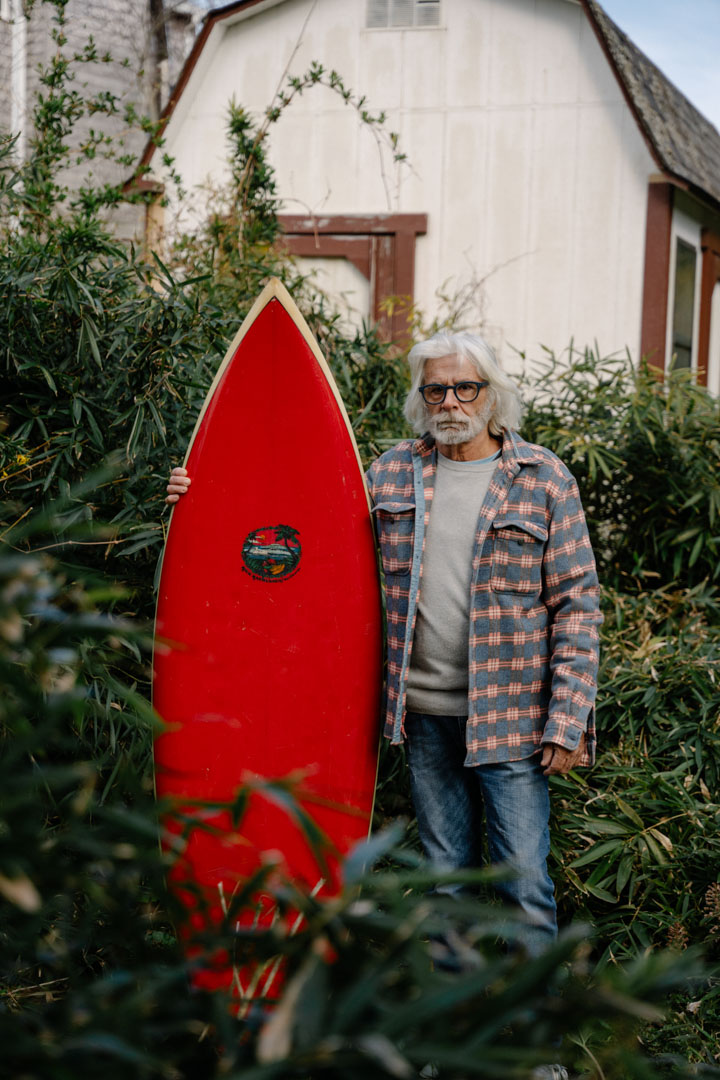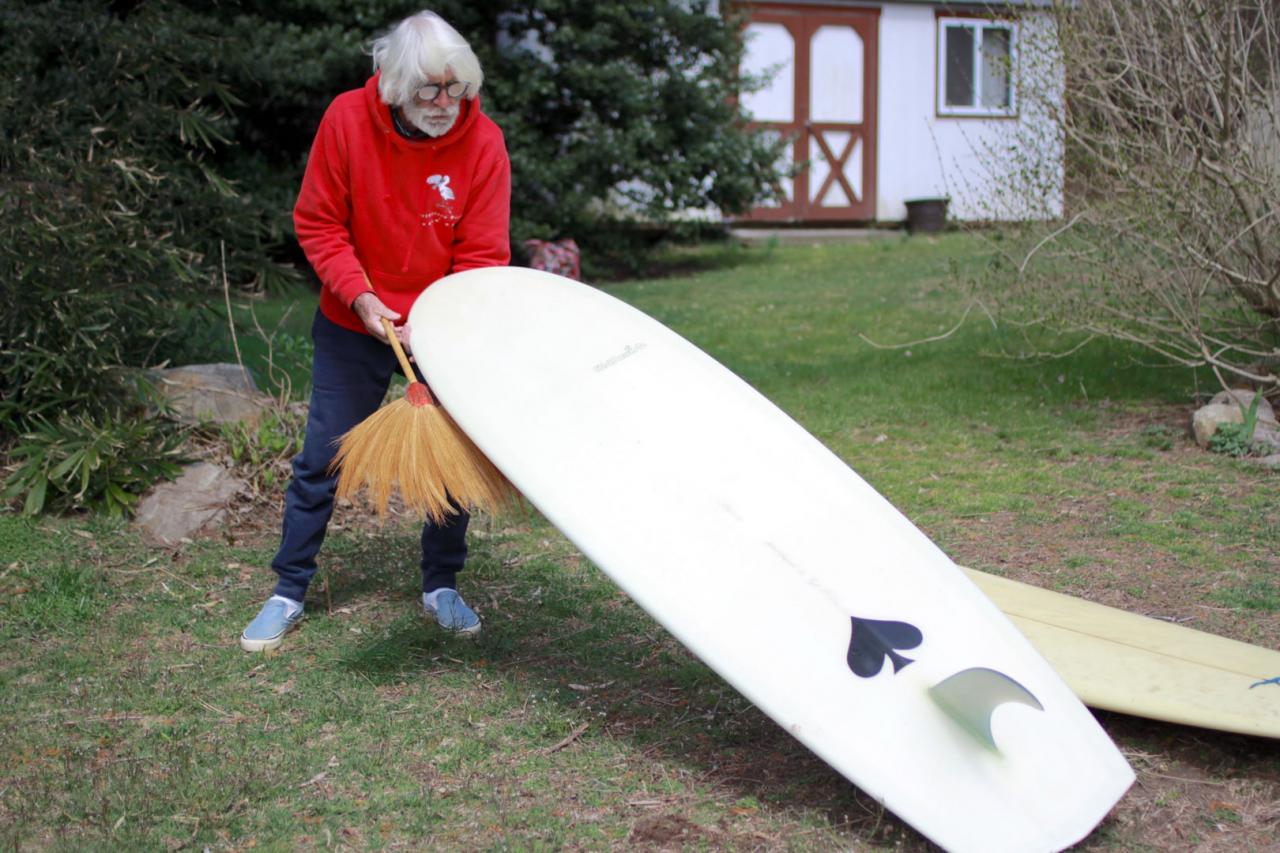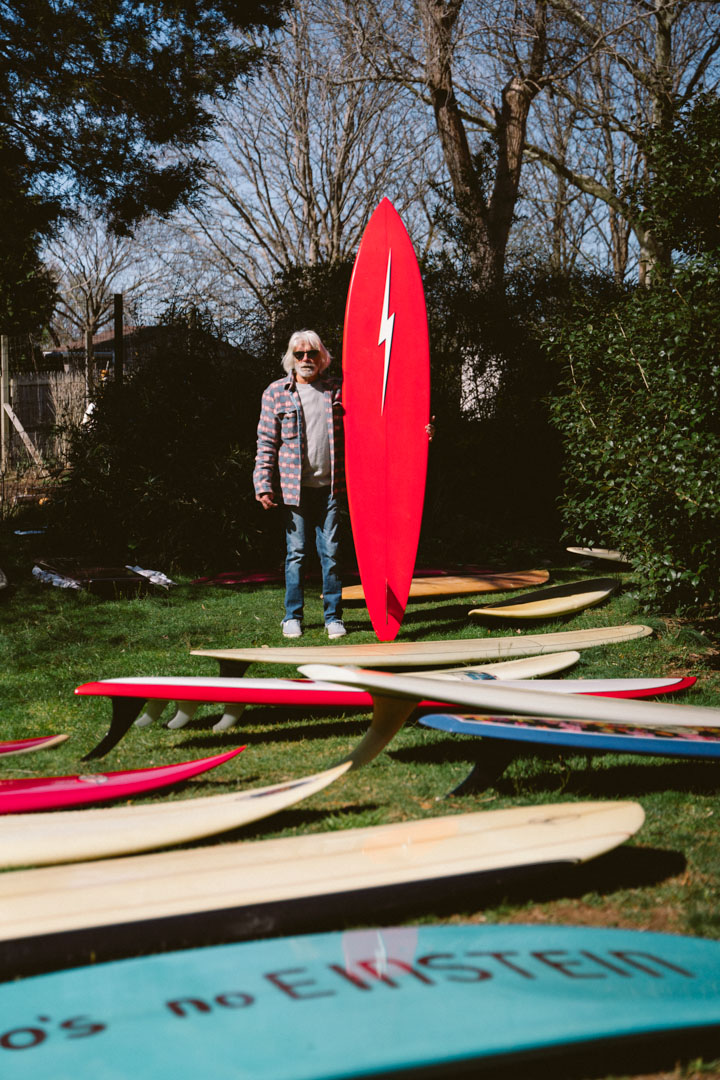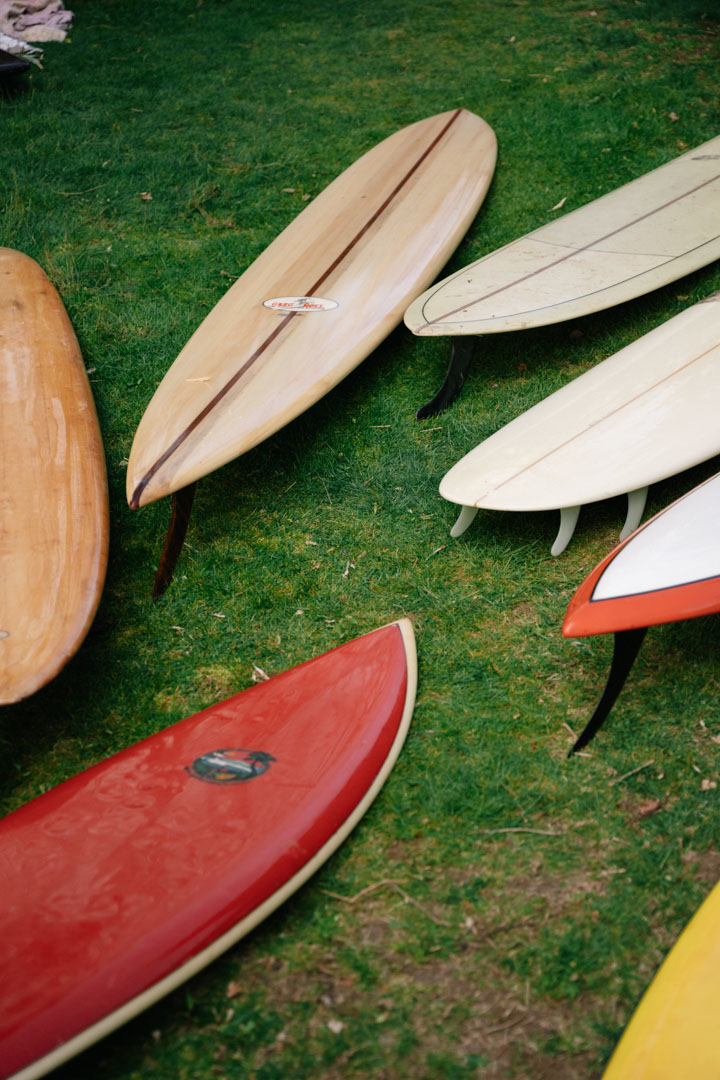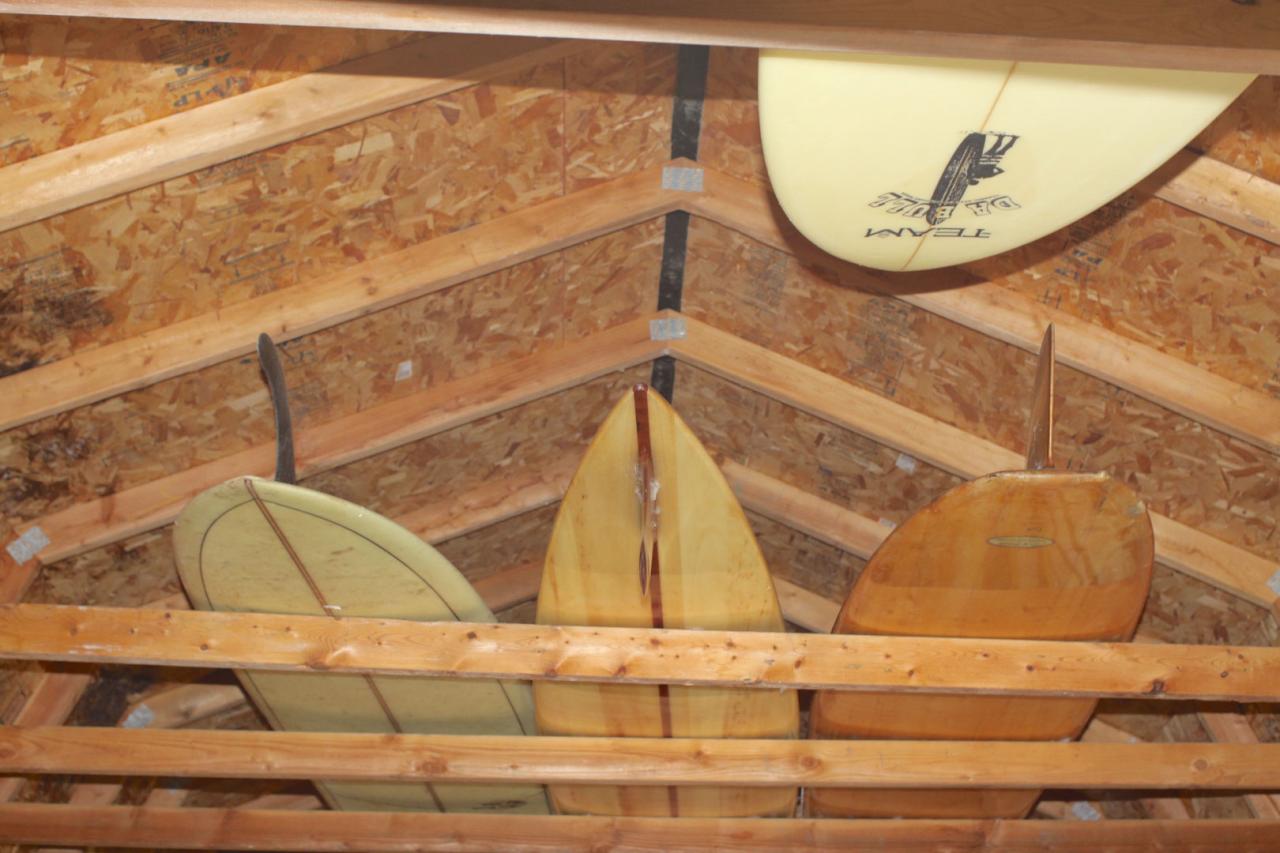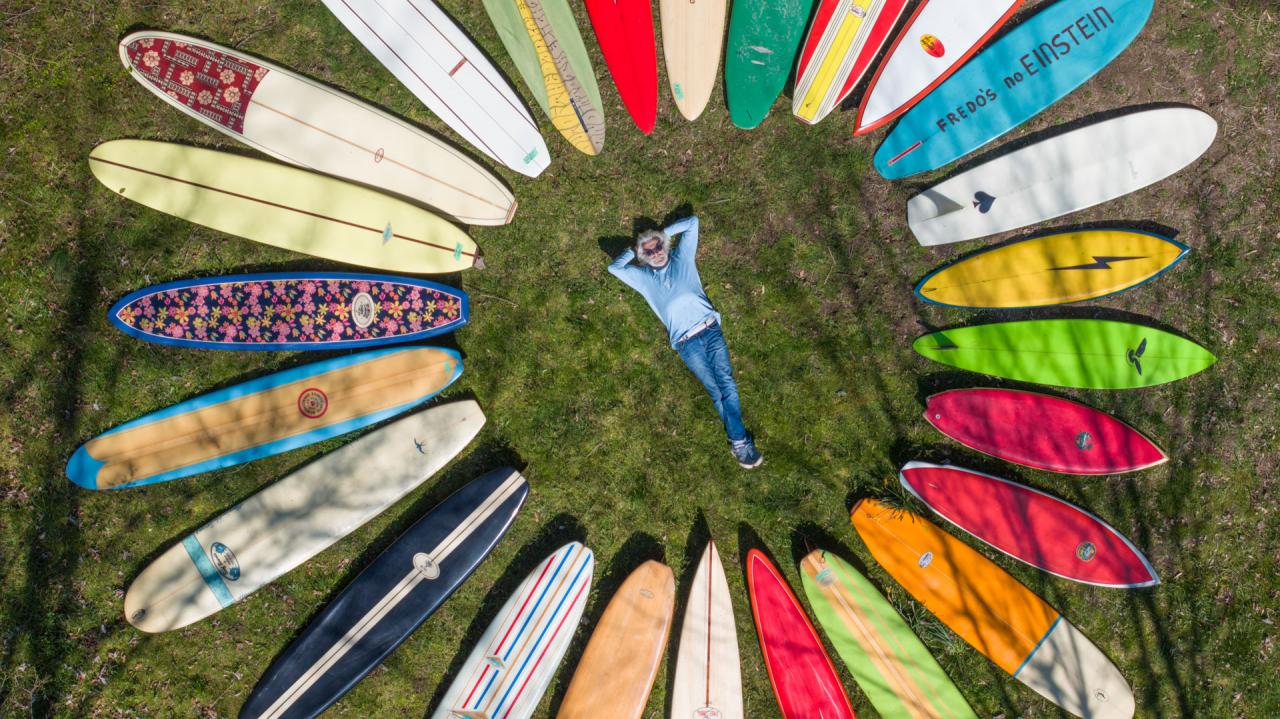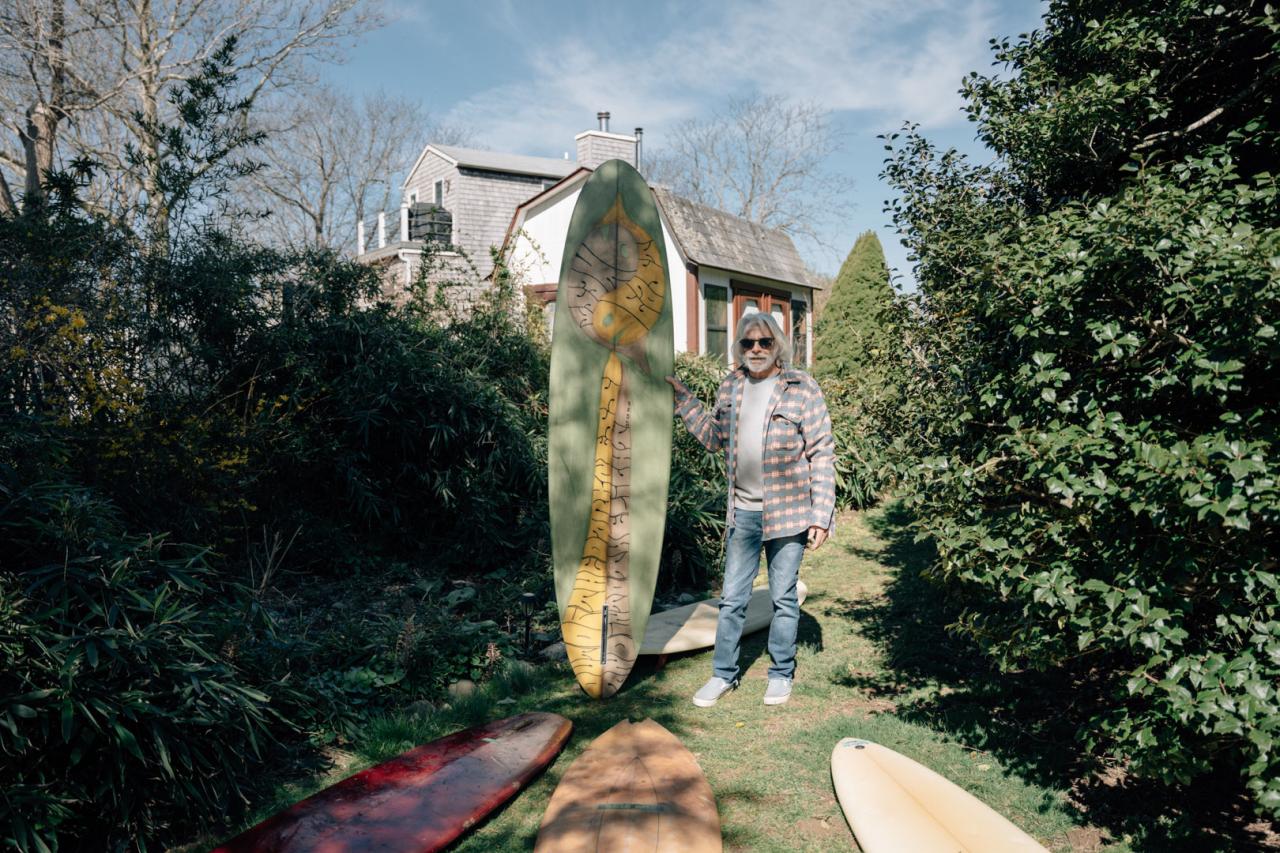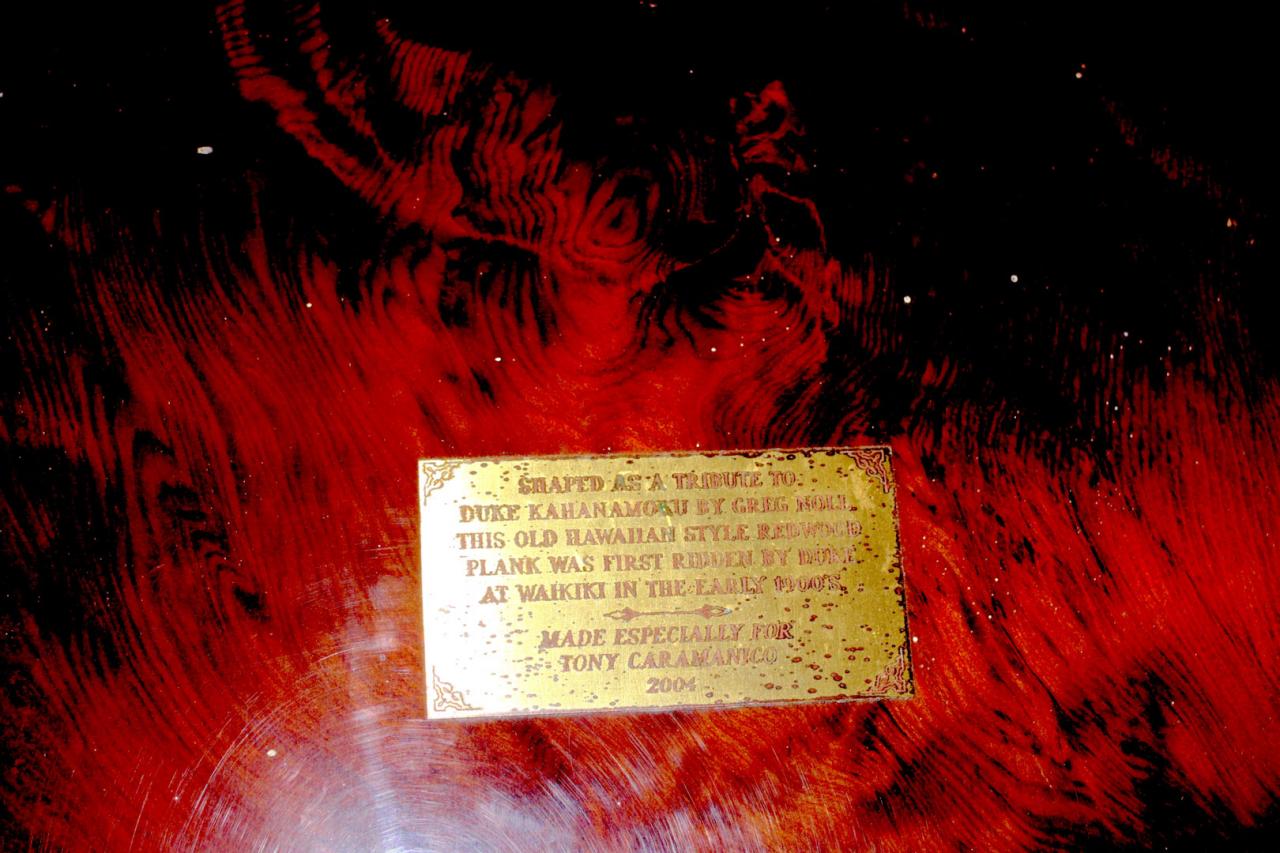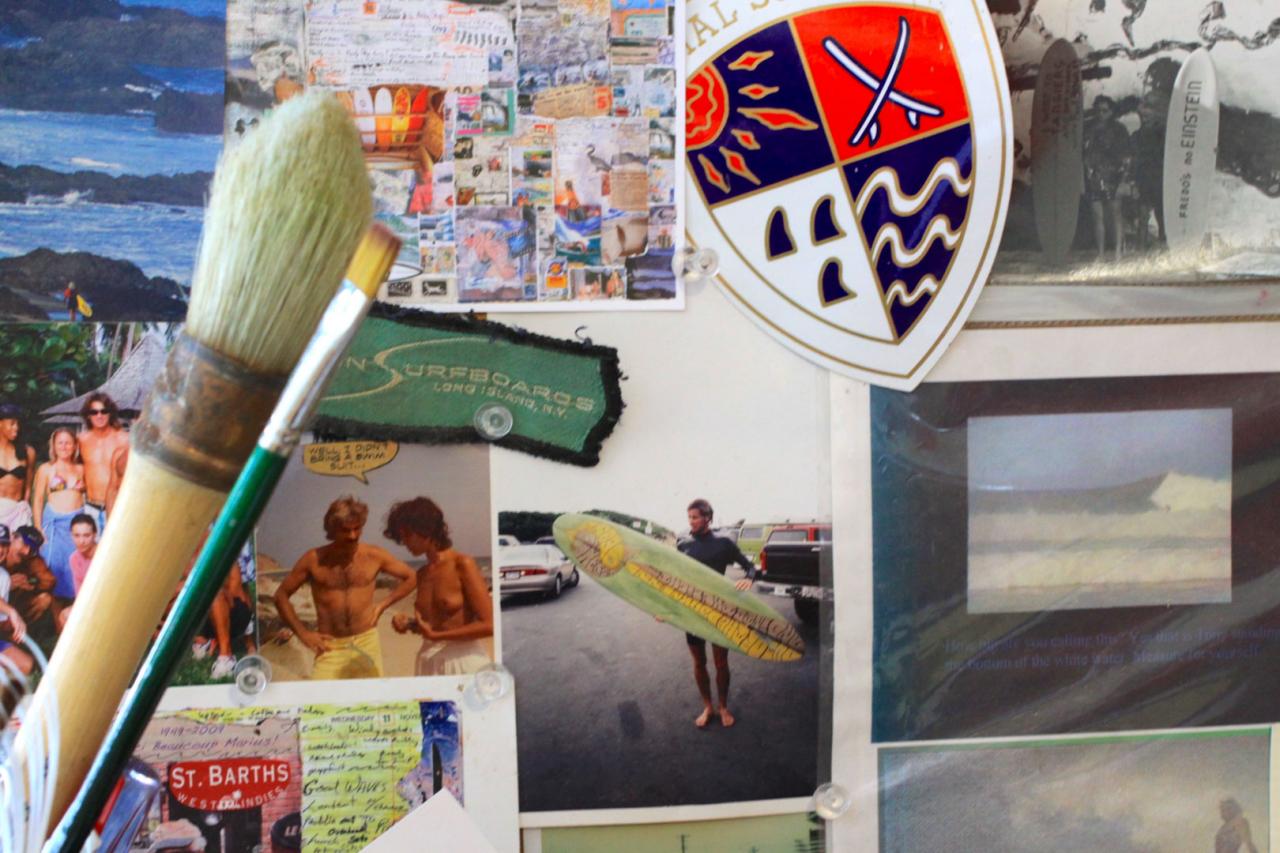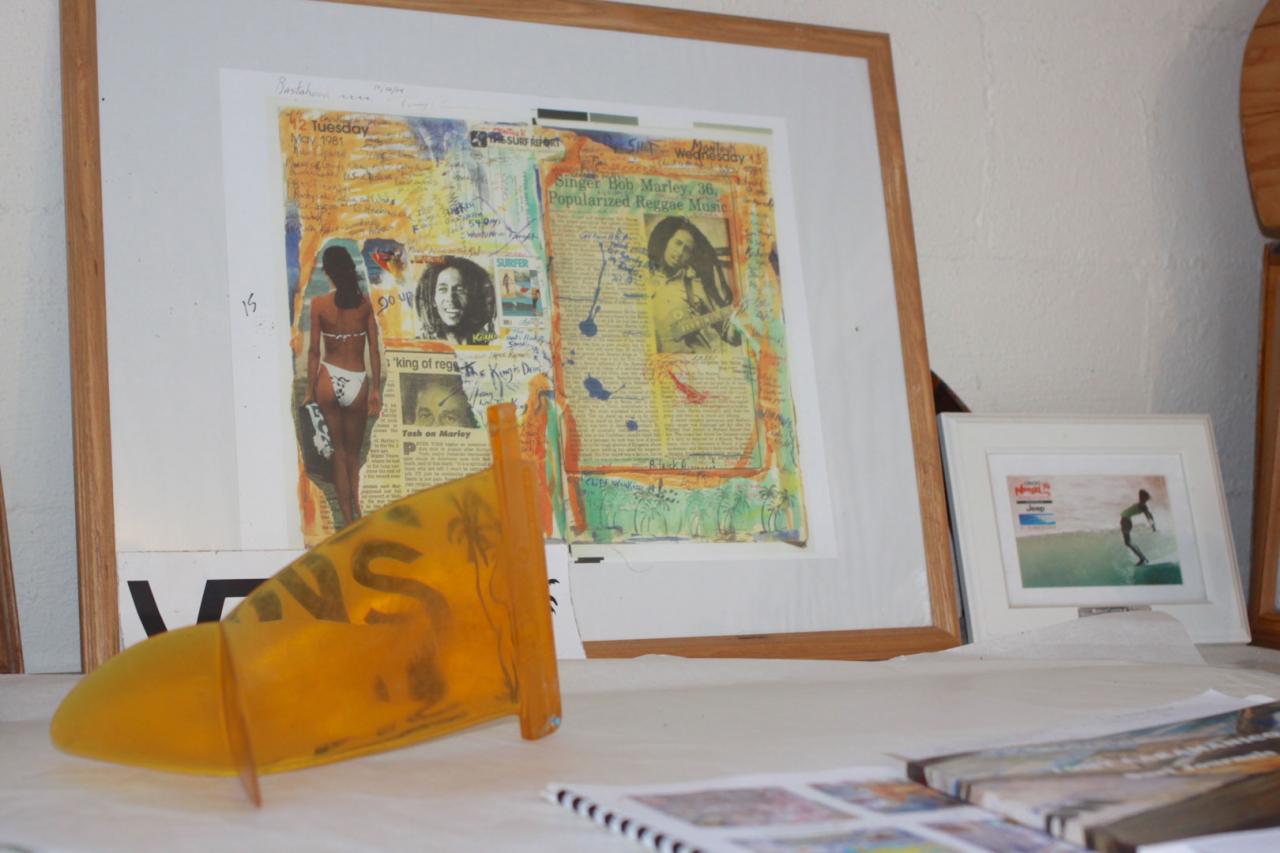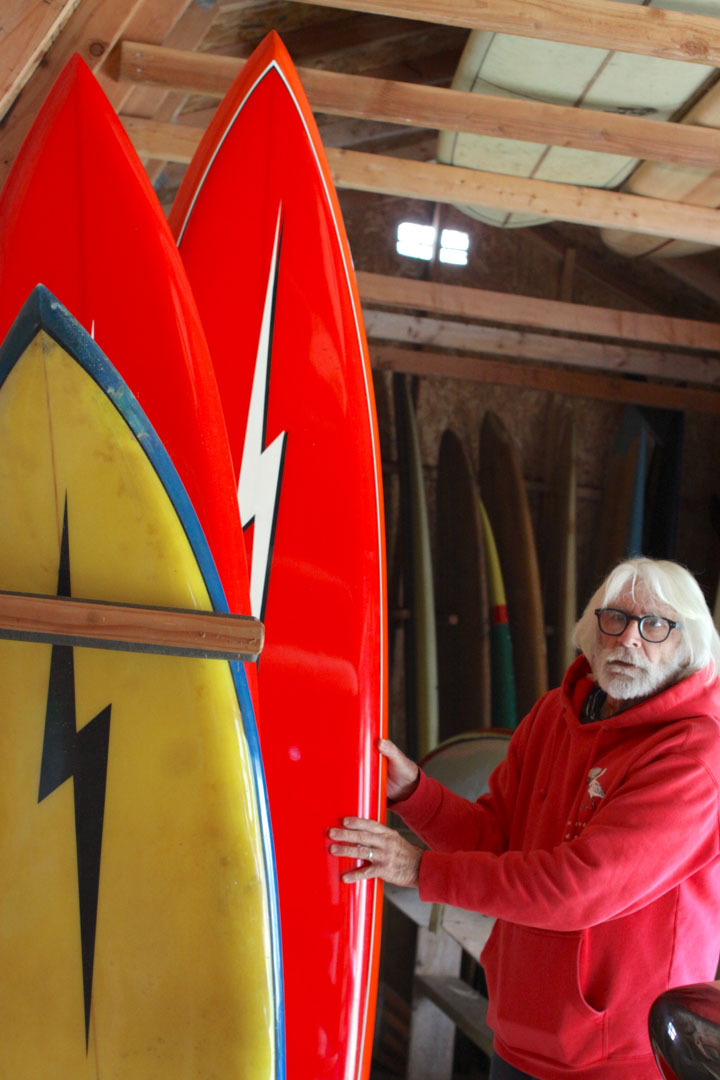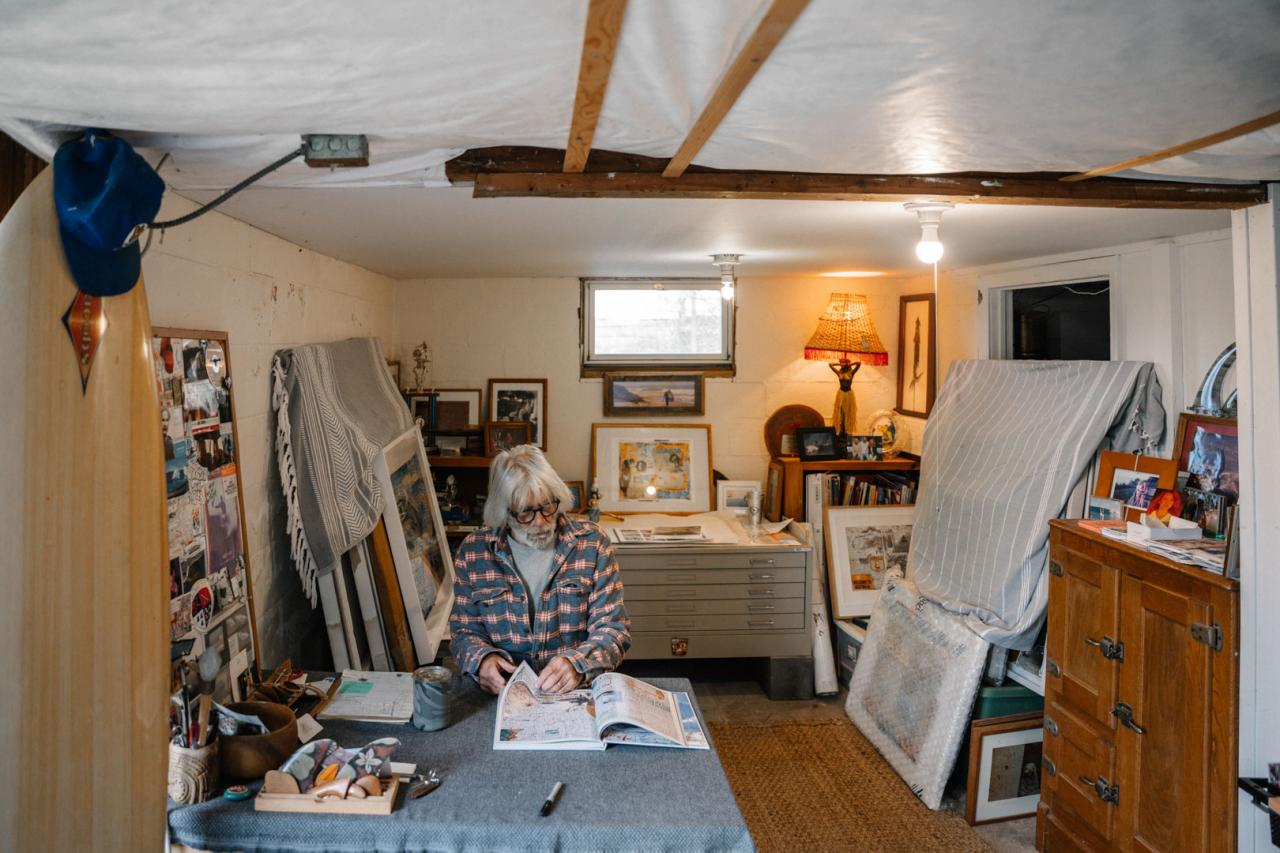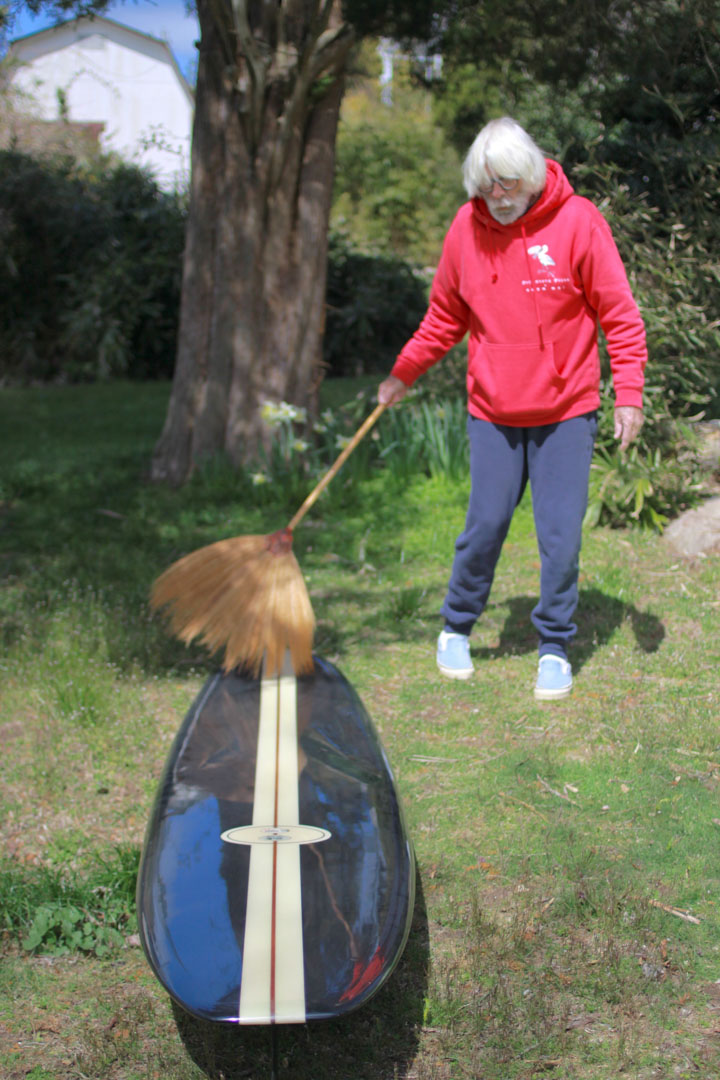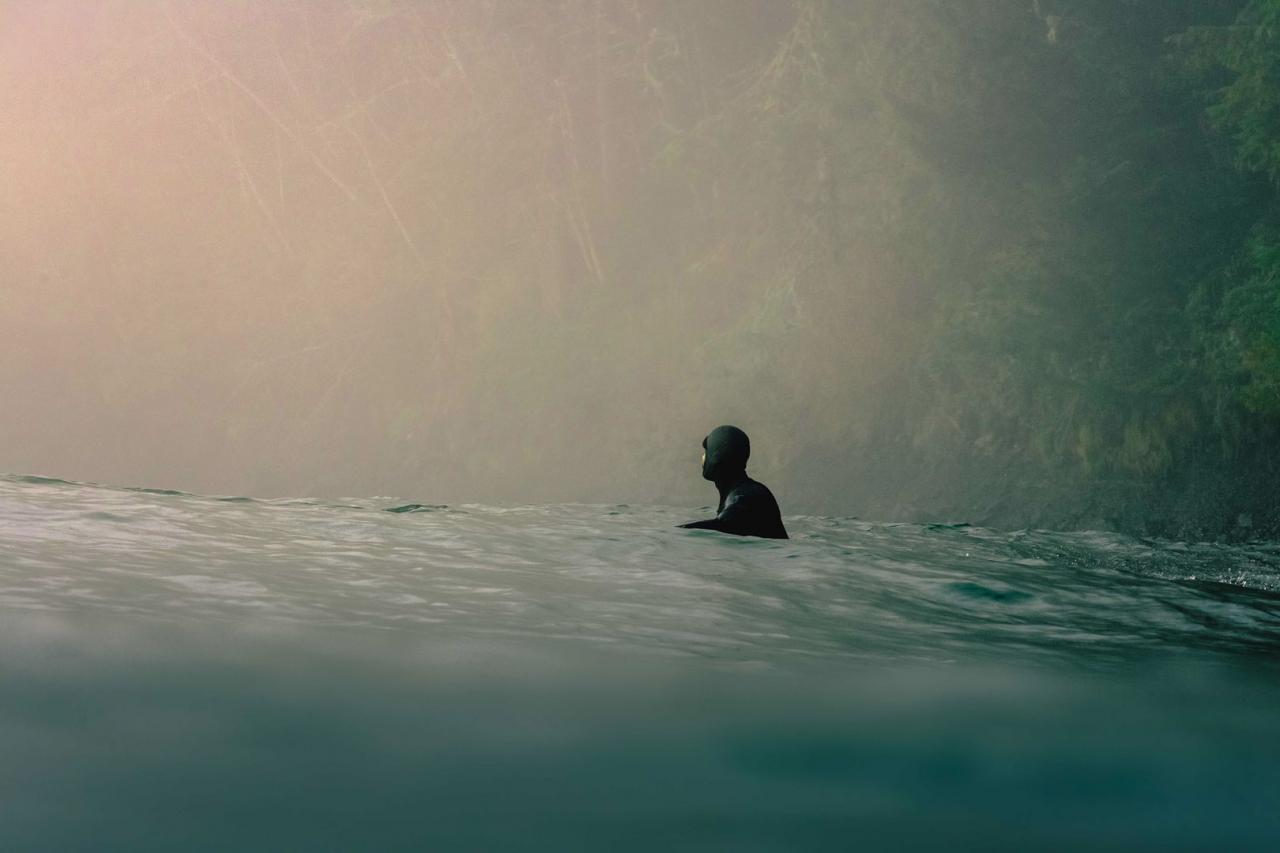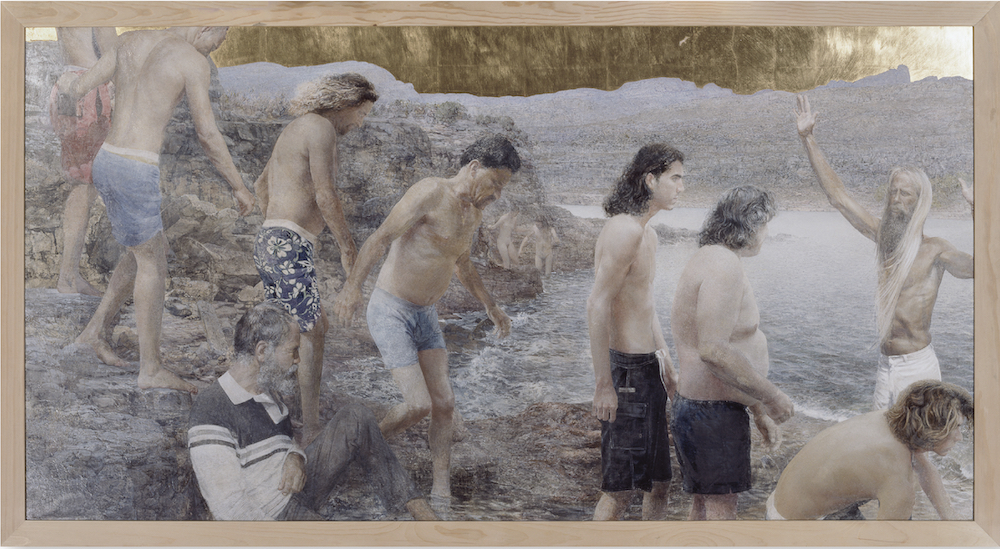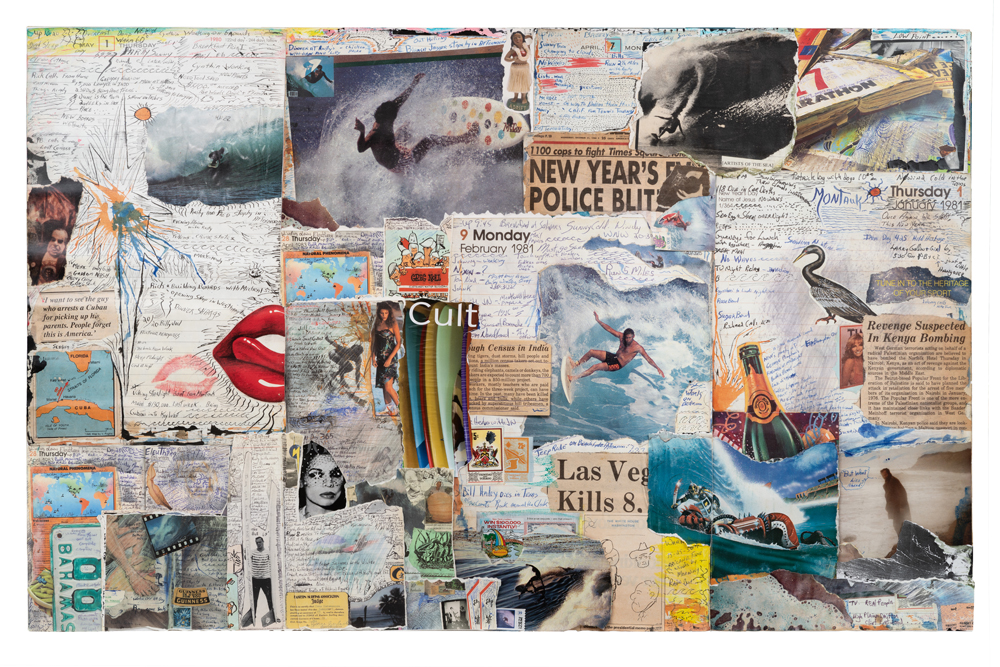Let me give you a history lesson.” — Tony Caramonico, aka “TC”, says this while standing at the door of a white barn in the backyard of his house in Montauk, New York. He turns, gives a glimpse of a rare smile behind a silver beard, and turns to unlock the barn — the barn I have come to call The Board Barn Time Machine.
TC has been a real-life legend in the surf scene since the 60’s and has managed to continuously evolve and adapt within surf culture through the decades. He has been a competitive champion, surf shop manager, sponsored surfer, world traveler, wave pioneer, surf shop owner, artist apprentice to Peter Beard, surf instructor to celebrities (before that was a thing) and now, a successful artist using multimedia to create visual representations of his surf journal from his lifetime on the water. TC’s home is a living artifact full of surf history. Let’s walk in together and hear him talk story.
Behind the door of the barn is a board collection that spans the entirety of the modern surf era extending from Duke Kahonamoku to present day. Each board represents a specific time in surfing history and comes with a story. Each story is a portal to a different time and place within the surf culture, its rich and varied history and folklore. TC turns a key and unlocks the door. He walks in and the surf stories begin to pour out, decade by decade.
“Here is an original Gerry Lopez from 1969,” he says. Gerry Lopez. The Loper. Mr Pipeline in the 70’s. Gerry Lopez is responsible for inspiring entire generations of surfers in the technical art of tube riding and surfing with a soulful style. “Look at these two,” he says as he pulls a couple of highly distinguishable boards from the rack. “BK Lightning Bolts from probably 1971.” BK is short for Barry Kanaiaupuni, who was one of the greatest innovators and chargers on the north shore of Hawaii during the 70’s. The two Lightning Bolt boards, one red and one orange with the iconic lightning bolt graphic down the center, are in mint condition. They are works of art, actually. Just looking at them makes you feel like you’ve slipped through a crack in time and have been transported back to Pipeline in the 5 Summer Stories Era.
Before I have time to geek out, TC continues on.
“Now this one, this is Butch Van Artsdalen from ’68-’69,” he continues. “I won the Gilgo Championship on this board that same year.” Gilgo is a beach break in the middle of Long Island, New York where they used to hold the East Coast competitive surfing championships back in the day. Butch Van Artsdalen is perhaps one of the greatest surf legends ever. He came out of California, pioneered Pipeline, Sunset, and was even known to go left at Waimea. In fact, Butch was the first “Mr. Pipeline”, and is who Gerry Lopez inherited the title from as he ascended in skill and fame. Just this board alone that TC is currently sliding back into the rack is a living surf artifact, a portal through time that spans championship level surfing from the North Shore of Oahu to the South Shore of Long Island.
“This is cool,” he says. “An original Transition Hansen 50/50 mid-length from when the board began to go down in size every month. Here is another Hansen, this one was a classic popular model, the Redwing.”
He touches a longboard with a stripe across the nose and slides it out for me to see carefully, “This is Joel Tudor’s World Contest Board shaped by Donald Takayama.”
He continues down the line, ticking off boards and moments in surf history. “Bunger Flower Deck,” Bunger is the original surf shop in NY from the ‘60s. It continues to be family-owned and operated in the heart of Long Island and is still a staple in New York surf culture. That flower deck board holds a bookmark in time.
He pulls a board from the rack that I recognize immediately. “This is Joel [Tudor]’s first transition board, probably from 1999. This was when he was leading the transition into mid-lengths and alternative surf crafts. I remember when Joel showed up with Thomas Campbell and the whole ‘Seedling’ crew. He actually painted the bottom of this himself. The whole theme is East meets West.” TC also has a picture of Joel holding the board in 1999 in a parking lot in Montauk. Tudor is known for progressive style and keeping longboarding alive while also leading the way into the alternative board realm and board riding movement. The mid-length TC is showing me is a legitimate piece of surf history, marking Tudor’s transition to shorter boards. It captures the moment when he influenced “longboarders” to become well-rounded surfers.
‘The Seedling’ was a renowned, ground-breaking film by Thomas Campbell. Campbell’s subsequent films, ‘The Sprout’ and ‘The Present’ were messengers to the surf culture of the surf-everything ethos. This was an evolutionary turning point in board design and surfing’s progression.
TC moves to a stunning, gleaming board standing in a place of honor in the middle of the barn. “This is an original Ben Aipa that was restored by Randy Rarick. Pretty incredible because Ben was one of the best shapers from back in the day and Randy is the best in the business at board restoration. He’s a real artist with it.”
TC moves through all of this rather quickly, transitioning from one board and time period to another without pausing, leaving me spinning from the historic, iconic boards all standing together in this incredible time machine of a barn. Finally, he pauses, and looks over at a few boards to his right.
“Here we have a Ricky Rasmussen. This is the last board Ras made me before he died. With this one, he says, we were at G-Land together with Gerry [Lopez]. The year was 1980. I had actually convinced ABC Sports Studios to do a surf special. It was the first televised surfing event that wasn’t an actual surf competition. The Studio flew us out there with a whole crew. The three of us were out in the jungle when there was no one else around, surfing these firing eight to ten foot waves. The ABC sports team couldn’t believe it. Those were amazing times. It's too bad what happened to Ricky. He was one of the best surfers in the whole world, truly world class, and he loved the waves there. He was actually the one who built the famous tree house with Gerry at G-land. The problem was, he loved partying and drugs too much. It caught up to him.”
For those who don’t know, Ricky Rasmussen was the greatest surfer to come from New York during that time period. He was essentially the first globally recognized professional surfer in New York, competing against top surfers of the era at the world’s most iconic breaks, like Pipeline. He was tragically killed during a drug deal gone wrong. The history that TC was referring to, the fact that he had spent time with him in G-Land and owned a few of his last boards, is truly amazing.
TC turns his head and looks up at a board in a horizontal rack. The energy ticked back up. “This is a replica of the original shortboard: The Fantastic Plastic that Bob McTavish brought to Hawaii when he famously failed at Sunset before blowing everyone’s mind at Honolua Bay. This is replica #7 that Bob made when boards started dropping in size every month and the V-shaped bottoms began to take over. See the Black Spade on the bottom? That was McTavish’s original logo.”
He looks up and points towards the boards hanging overhead, “Then up here in the rafters, we have three special shapes: this is the board that Donald Takayama made Joel [Tudor] for his 21st birthday. Joel actually got it here and has left it with me ever since. It’s still his board but,” he adds with a laugh, “its been here for like 25 years.”
He points to the next board overhead, “This is a Jose Angel Model shaped by Greg Noll. Look at that balsa wood with a redwood fin.” Jose Angel was known as a surfing giant from Waimea in the early 60’s. He surfed giant, heaving Waimea like it was just a normal five foot surf break. He was famous for doing back flips off the peak on thirty foot waves just for fun. He was a mad man.” The board that TC pointed out was the kind of board that Angel would ride during those momentous occasions.
“This last one is a 1957 Velzy, an original Malibu chip design,” TC explains. This is the board they rode at Malibu in that time before surfing blew up and there was the whole explosion in the 60’s. It was the time when there were just a few people out at first point and surfing was an art for rebels and outcasts. The Malibu chip is the premier board design model to come from that era. It was the height of surf design and performance at the time.”
He looks back down from the rafters and points to two boards that looked oddly familiar, perched in racks against a far wall of the barn.
“Now, these are really special,” he says. “These are the ‘Endless Summer’ boards from the 1966 film. The Smithsonian was having a luau to celebrate surfing’s official integration into American culture. I was there with everyone you can imagine for the event and they actually had a board auction. These are the exact replicas of the boards that Mike Henson and Robert August rode in ‘Endless Summer’. Mike and Robert were at the Luau and the boards were signed by them. I had to get them.”
Next, he looks down at the floor where there lies a gigantic, polished piece of redwood. It is shaped from a definitive era and there is a commemorative plaque affixed to the deck. It’s easy to see that this is something special. “This is a replica of the Original Duke boards from the beginning of the 20th century,” says TC. “It’s solid redwood and you see that bronze plaque in the center of it commemorating it as a rare piece of surf history. [The plaque reads: ‘Crafted as a Tribute to Duke Kahanamoku by Greg Noll’ This Old Hawaiian Style Redwood Plank was first Ridden by The Duke at Waikiki in the early 20th Century. Made Especially for Tony Caramonico 2004’]. That one is extremely special,” explains TC. “It’s also so damn heavy, that’s why it's lying horizontal. I need to rearrange things to find the right spot for it. It’s like 60 pounds or something.” The polished redwood shimmered as I looked at it. It is the replica from when Duke was the ambassador of surfing to the whole world, competing in the Olympics in swimming and spreading Hawaiian culture, the spirit of aloha and the art of wave riding to the rest of the world. I was looking at the seed of all modern surf culture.
Finally, TC turns to the sleekest, sharpest, sexiest longboard in the whole barn with a gloss coated black deck holding a white stripe. “Really though, the most collectible surf shape in this barn is this restored, mint condition Black Cat by Greg Noll. This was like $17,000 dollars originally and I don’t even know what it’s worth now”, he says. “Fortunately for me, when I got this my art career had begun. I actually traded a piece of art for this!”
The most expensive board in the whole collection and Tony Caramonico obtained it by trading a piece of artwork? What an absolute legend. How did he manage that?
TC explains. “Well, in 1978 I moved in with Peter Beard here in Montauk. That had a huge influence on my art. I started creating my own artwork based on my travel journals a few years later, around 1980. But I didn’t start selling my work until 2001. Clic Gallery took me on and got me set up in St. Barths. Now it’s pretty crazy. I’ve got shows all over. The Financial Times is coming here to do a piece next week. And Damiana is publishing a book of my art. I’m really stoked on how that’s coming out.”
TC’s art is a multi-media conglomeration of his surf journals from traveling the world over several decades, both as a professional surfer and as a free surf icon. His creations combine words, drawings, pictures and memorabilia in a surf collage of creative experiential expression, similar to Peter Beard’s work from the same era. TC shows me his upcoming art book. It is a beautiful, coffee table style compilation of his best pieces of work. Getting it published by a high-end publishing house like Damiana in Italy is another exceptional story in an ever-evolving volume of surf history and culture that is Tony Caramonico’s life.
When asked to reflect on the biggest changes that TC has seen in 60 years of surf experience, he pauses to consider.
“I’d say the variety and diversity of surfing are the biggest changes. Designs used to just be longboards. Then, it was just short boards. But now it's different. Diversity is the biggest change. People are surfing every type of surf craft imaginable and now we have surfers from every corner of the planet and from every walk of life. As the population of surfers explodes, there is a lot more inclusion and more diversity within the surf culture, board designs, and the styles of surfing people. It’s really changed and contributed to the culture.”
When I heard that, I could only think of one thing: Diversity is health. Gardens that use polyculture (multiple types of plants that complement one another) are 10x healthier, more productive and longer lasting than monoculture gardens (gardens that only have one type of plant in a certain area). As the surf population grows and becomes more diverse, surfing is integrating world cultures and unique individuals, evolving into a global community of connected creatives. As we integrate our diversity, we become more healthy as individuals, communities and a culture as a whole.
Finally I asked TC, “After all this time, after decades of surfing, what is the biggest lesson that surfing has taught you about life?”
He answers, “Patience. Surfers are always waiting for waves. We want it to be good all the time, but we have to learn how to wait. We also have to keep pursuing it. So really, it has taught me to learn to look for that balance. Always pursue the things you love while having the patience to wait and let the things you want show up.”
We carefully store the boards back in the barn after today’s history lesson, and TC locks it up. I look back at the barn and realize it’s the culmination of living lessons that he has learned from a lifetime of surfing. The board barn has the diversity of the entire surfing world inside it, accumulated over 60+ years. The collection in that barn is the epitome of pursuing something with patience. TC always loved surfing and board designs. He has pursued this collection throughout his whole life, patiently waiting for the highest quality, most authentic boards, and capturing them at just the right moment.
Just like surfing, we are always on the lookout for the waves we are seeking and we need the patience to let them show up as they will. And, of course, we must be prepared when the surf inevitably comes. Pursue what you love, be patient and always be prepared for whenever it might show up. These are just a few of the pearls of wisdom that were distilled from a day of jumping through portals into the past with Tony Caramonico and his Board Barn Time Machine.

